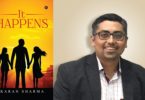“Knowledge is transferred through books; Wisdom is transferred through stories.”
Stories have been the medium of teaching for centuries, either knowingly or unknowingly. Telling stories is a human instinct, and most of us do so without realizing that there is a storyteller within us. And when one unlocks that storyteller, the possibilities become immense. Seema Chakraborty of Little Readers’ Nook (LRN) is one such storyteller, who adopted storytelling as a primary teaching tool.
A person highly passionate and enthusiastic about education, Seema’s love for teaching kids at primary school level, around the world, goes many years back. She believes in fostering a joy for learning, and developing inquiring minds. Her classroom is always abuzz with stories, creativity, enthusiasm, music, dance, drama, art and laughter. She encourages young children to become active participants in the activities. This is done through asking questions and then trying to find answers through guided explorations. Her journey as a teacher took her into an exciting world full of stories and made a storyteller out of her.
We chatted with her about her love for stories and storytelling. Here are some excerpts.
What influenced you to become a storyteller?
I grew up listening to stories. My grandpa introduced me to this world of stories. I have been an avid reader since my childhood. My father had this huge library at home. I grew up reading many books of various genres. My childhood was, thus, spent engrossed in this fantasy world. We even had a Secret Seven Club, thanks to Enid Blyton, one of my favorite authors, who taught me to imagine and create a wonder world.
Stories fascinated me and as I started teaching, I found that children always enjoy ‘story–time’. After being in the teaching profession for fifteen years I thought of venturing into the world of stories. Stories are the best and simplest way to teach children; any concept, any subject becomes putty when molded with stories. And from there came the idea of being a story-educator.
I set out as a storyteller holding the hands of Little Readers’ Nook. Devaki, the Founder has been extremely helpful. I just had to find my audience, which sometimes proves to be a challenge. Since I have been in the teaching profession, I could easily connect with young children and this is how my journey began.
What are the kind of audiences you work with? Which is your favorite audience?
My audience ranges from the tiny tots, that is 2 years, to children of 7 years. This entire age group appeals to me. I get this magical feeling when I see children, its like a magnet. I am attracted towards them like the Pied Piper of Hamlin!
How have the stories in your life influenced your style of storytelling and the way you use stories?
My grandfather has influenced me tremendously. His stories were powerful and had an immeasurable impact on me. I often recollect those bed time stories when we siblings would curl up and listen to my grandfather intently. He was the storyteller. And now I have become the Story-Wallah Aunty in my community, hoping to have the same impact and evoke the same feelings.
In this digitized world with nuclear families and both parents working the Story-Wallah Aunties play a very important role in children’s lives. It is an immense responsibility. My work experience as a teacher has also helped me as a story-educator. A teacher is a great actor. She weaves and enacts stories throughout the day. I have done that for fifteen years and want to do it for the rest of my life. I love it so much.
Any particular incident/anecdote from your workshops/sessions that is special to you?
All sessions are very exciting and special. When I see the happy smiles on children’s faces, when they make beautiful cards as a token of appreciation and when they yearn to come to my class even when they are unwell – all these experiences give me special satisfaction as a storyteller. One particular incident which makes me smile is about this young boy who was so engrossed in the story character (Bablu the barber) and dress-up play after the story session. He went back home and refused to erase the mustache on his face. His mother had to allow him go to sleep with the painted mustache!
Any story that you particularly love using?
There are so many stories that I like from around the world but Gajapati Kulapati by Ashok Rajagopalan I particularly love reading over and over again. The story is set in an Indian village. It attracts all children because of the Indian name as well as the loud sounds like Dhaamal, Pchaak, Whoosh, which it offers for use to the storyteller. Children love these sounds.
Do you think storytelling can be adopted as a full-time profession? Your advice to those who want to do so.
Storytelling can definitely be adopted as a full-time profession. As they say the world is made of stories.One simply needs to find the right place and reach out to an audience who will be attracted. Everyone loves listening to stories, be it children or adults. At my classes, parents are often as engrossed in the story as the children. There are ample international storytellers who have carved a niche for themselves in the world of storytelling, setting great examples. In India we need to encourage and promote the culture of storytelling.
Like any other profession, you should enter this career if you are ready to commit your 100% to it. It helps if you are passionate about reading and acting. A storyteller is also a dreamer and is often required to venture into an imaginary world full of wonderful characters. That spark of creativity is essential.
Your advice to parents and teachers on why and how they should keep stories alive.
Children are the happiest listening to stories, says research. Stories help them develop Reading Readiness skills – vocabulary, narrative skills, creativity, knowledge of the world, an awareness of letters and sounds in words, a strong desire to read and a lifelong love for books. Dramatic story narration coupled with strong visual imagery and lots of sensory details works on a child’s imagination and listening skills.
Keeping all this in mind, parents and teachers should read to their children from an early age and everyday. There is not stipulated age to start reading to kids. There is a term in the teaching world that says DEAR that is Drop Everything And Read. That’s all that is needed – DEAR.
—
Seema Chakraborty is a storyteller with LRN. Read more about Little Readers’ Nook here.
Don’t Miss: We love storytellers as much as we love storytelling. On Tell-a-Tale, we’ve featured a lot of talented storytellers, in the past.
Are you a Storyteller? If you’re a storyteller who is actively pursuing storytelling and would like to be featured in this column, drop us a mail at contact AT tell-a-tale.com or reach out to us via Facebook or Twitter.




